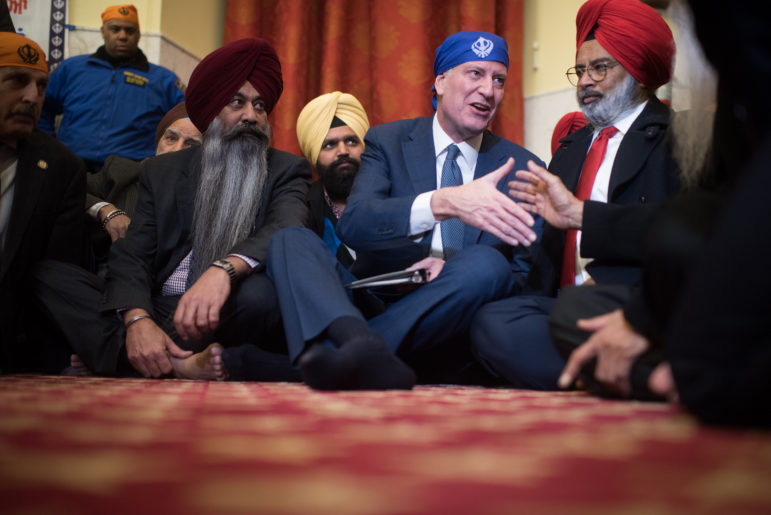
Michael Appleton/ Mayoral Photography Office
Mayor Bill de Blasio visits the Gurdwara Sikh Cultural Society in Queens in 2017. Surveys indicate that Sikhs in New York City suffer widespread harassment.
April is the holiest month on the Sikh calendar, and on April 28th more than 50,000 brightly costumed Sikhs will celebrate Vashaki (also called Baisakhi) at the annual Sikh Day Parade on Madison Avenue. A joyful and festive celebration of the baptism by the tenth Sikh Guru, the parade gives many Sikhs the opportunity to show their Sikh pride, and offers non-Sikhs a window of understanding into the world of Sikhism.
This urgent need for understanding is a backdrop to the parade, on the minds of many Sikhs even as revelers arrive at Madison Square Park at the end of the parade to participate in langar—or the offering of free foods, where 50,000 Indian vegetarian meals will be distributed to anyone who wants one—because bias attacks against Sikhs, both adults and school children, are far too familiar to many in the community.
In fact, a study by a Sikh advocacy group showed that Sikhs are 100 times more likely to be assaulted than the average American citizen. And it’s not just adults who are insulted and attacked, but a large percentage of Sikh schoolchildren are subjected to bullying in school, especially in Queens, the home to the city’s largest Sikh population.
All children deserve a safe learning environment. But even in our diverse city Sikh students experience high rates of bullying and harassment in public schools. As with many other forms of bias, we have seen an increase in the Donald Trump era. In 2017 there was a sharp uptick in incidents of bullying against Sikh students. Sixty-seven percent of Sikh students nationwide report instances of bullying. The number of Sikh students citywide who experience these bias attacks reflects the national average.
Sikh boys who wear turbans are frequently called terrorists, have had their turbans forcibly removed and their hair cut. Sikh girls are teased for having unshorn long hair. Some have even had their long braids cut by other students. How does one explain to a child that they were attacked because of their religious beliefs, and, more importantly how do we prevent it from happening again?
The city’s Department of Education passed a rule in 2003, and updated it in 2011, meant to help put an end to this type of bullying, DOE regulation A-832. This regulation was a response to a series of high-profile attacks against Sikh students. But too often teachers and students don’t know, or don’t care, that the city has rules against school bullying and discrimination.
Early in his tenure, new Schools Chancellor Alberto M. Carranza declared his intention to empower neglected students, and to ensure school safety. He needs to make certain that he is focused on students of all communities, not just a select few. When it comes to bullying based on bias, he needs to do more than simply enforce anti-bullying regulations, but to also support a global multi-cultural curriculum—a curriculum that begins with an understanding of all the students in our schools.
A school system of the magnitude of New York’s has a particular obligation and a unique opportunity to develop and implement such a curriculum. Chancellor Carranza must embrace a global multi-cultural curriculum that optimizes the study of groups that have been previously ignored. And our Sikh community must be included in such a curriculum.
If we believe that education is the first step towards a more harmonious culture, this is a path to reducing bullying and harassment in schools. For students and teachers alike, the deliberate studying of another culture improves and expands one’s understanding of how to learn. In a world that is becoming increasingly multi-cultural, the ability to understand otherness and embrace differences may be the defining characteristic between those who succeed and those who do not.
The chancellor needs to create a better environment for students, in and out of the classroom, both Sikhs and non-Sikhs, so they can focus on their studies, rather than the bully down the hall. He can do this by making sure the existing rules against discrimination of students are understood and enforced, while creating classroom curriculum that enhances mutual understanding.









One thought on “CityViews: As City’s Sikhs Celebrate, They Hope for New Action to Stop Bullying”
Pingback: CityViews: As City's Sikhs Celebrate, They Hope for New Action to Stop Bullying | English Sikh